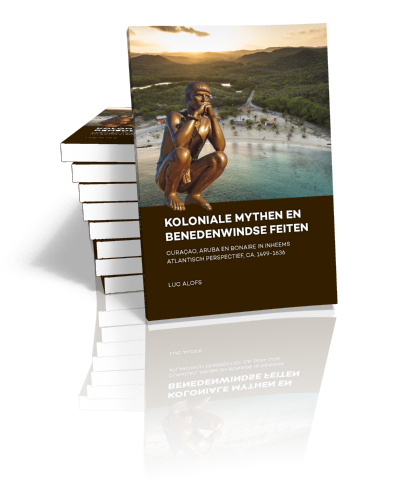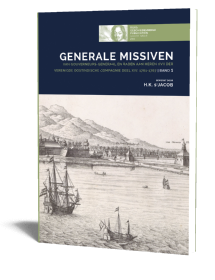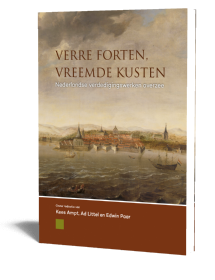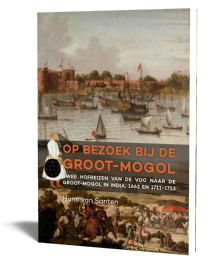Koloniale mythen en Benedenwindse feiten
Curaçao, Aruba en Bonaire in inheems Atlantisch perspectief, ca. 1499-1636
Luc Alofs | 2018

Koloniale mythen en Benedenwindse feiten
Curaçao, Aruba en Bonaire in inheems Atlantisch perspectief, ca. 1499-1636
Luc Alofs | 2018
Paperback ISBN: 9789088906015 | Hardback ISBN: 9789088906039 | Imprint: Sidestone Press | Format: 182x257mm | 176 pp. | Language: Dutch | 12 illus. (bw) | 28 illus. (fc) | Keywords: Curaçao, Aruba, Bonaire, archaeology, Atlantic history, Benedenwindse eilanden, Leeward Antilles, Caquetío’s, cultural studies, encomienda, ethnohistory, humanism, native studies, Inquisition, colonialism, literary sciences, occidentalism | download cover
Read online or downloaded 4978 times
-
Digital & Online access
This is a full Open Access publication, click below to buy in print, browse, or download for free.
-
Buy via Sidestone (EU & UK)
-
Buy via our Distributors (WORLD)
For non-EU or UK destinations you can buy our books via our international distributors. Although prices may vary this will ensure speedy delivery and reduction in shipping costs or import tax. But you can also order with us directly via the module above.
UK international distributor
USA international distributor
-
Bookinfo
Paperback ISBN: 9789088906015 | Hardback ISBN: 9789088906039 | Imprint: Sidestone Press | Format: 182x257mm | 176 pp. | Language: Dutch | 12 illus. (bw) | 28 illus. (fc) | Keywords: Curaçao, Aruba, Bonaire, archaeology, Atlantic history, Benedenwindse eilanden, Leeward Antilles, Caquetío’s, cultural studies, encomienda, ethnohistory, humanism, native studies, Inquisition, colonialism, literary sciences, occidentalism | download cover
Read online or downloaded 4978 times

We will plant a tree for each order containing a paperback or hardback book via OneTreePlanted.org.
De geschiedschrijving van de zogenaamd Spaanse periode van de Benedenwindse eilanden Curaçao, Aruba en Bonaire (ca. 1499-1634/6) wordt nog steeds gedomineerd door koloniale mythes over inheemse bewoners en Spaanse encomenderos. Inheemse bewoners worden beschreven vanuit een eurocentrisch perspectief ofwel als Giganten (Vespucci) ofwel als volgzame onderworpenen van Europese kolonisatie. Al in 1588, verdedigde Juan de Castellanos in zijn ‘Elegías de los claros varones de Indias y la historia del Nuevo Reino de Granada’ het encomienda systeem en prees hij de Benedenwindse encomendero’s Juan de Ampiés en Lazaro Bejarano. Twintigste eeuw historici reproduceerden deze koloniale verbeelding van de Benedenwindse eilanden. Europese nieuwkomers werden afgebeeld als de brengers van het christendom en humanisme of als oprichters van het (post) koloniale context van de Nederlandse Antillen.
Ook literatoren werden beïnvloed door deze koloniale mythen. In 1970 liet arts en dichter Chris Engels (pseudoniem: Luc Tournier) archeologisch onderzoek in Aruba uitvoeren om uit te vinden of de inheemse bevolking inderdaad Giganten waren. Cola Debrot baseerde zijn novelle _De Vervolgden_ (1981) op het werk en leven van christenhumanist Bejarano. Humanist Frank Martinus Arion pleitte in 2003 zelfs voor het oprichten van een standbeeld voor Bejarano: ‘_als de eerste Curaçaose bestuurder die zich met hart en ziel voor ons eiland heeft ingezet en zijn nut meer dan eens bewees. Bovendien was hij één van de eerste humanisten van de nieuwe wereld_’. Deze publicatie is een exercitie in het deconstrueren van koloniale mythen en het tot stand brengen van een gedekoloniseerde inheems Atlantische Benedenwindse geschiedschrijving.English abstract
The historiography of the so called Spanish period of the Leeward past (ca. 1499-1634/6) is still dominated by colonial myths about the indigenous inhabitants of the islands of Curaçao, Aruba and Bonaire and Spanish encomenderos Juan de Ampiés and Lazaro Bejarano. Indigenous inhabitants are described from a Eurocentric perspective either as Giants (Vespucci) or as docile subjects of European colonization. In 1588, Juan de Castellanos in his ‘Elegías de los claros varones de Indias y la historia del Nuevo Reino de Granada’ defended the encomienda system by praising De Ampiés and Bejarano. Twentieth century historians have reproduced colonial imagination. European newcomers are depicted as bringers of Christianity and humanism or as founders of the (post-) colonial context of the Netherlands Antilles.
Also, modern literary authors were inspired by these colonial myths. In 1970, medical doctor and poet Chris Engels (pseudonym: Luc Tournier) implement archaeological research in Aruba to find out if the native population were Giants. Cola Debrot based his novel The persecuted (De vervolgden, 1981) on the life and work of Christian humanist Bejarano. In 2003, humanist and author Frank Martinus Arion pleaded for the creation of a statue for Bejarano: ‘as the first Curaçao governor using heart and soul for our island and more than once proved its usefulness. In addition, he was one of the first humanists of the new world’. This publication is an exercise in the deconstruction of colonial myths and the creation of a decolonized native Atlantic Leeward historiography.
Voorwoord
Over de schrijver
Conquista: koloniale mythen en Benedenwindse feiten
Verantwoording: bronnen en begrippen
1 Inheemse eilanden: een korte kennismaking
1.1 De lithische en archaïsche Benedenwinders
1.2 De neo-Indiaanse periode: de Caquetío’s
1.3 Mythe en Reconstructie I: kosmologie en dodencultuur
2 Ontdekking en verwoesting van het aards paradijs
2.1 De weg naar Indië
2.2 Verderf brengende messen
2.3Inter Caetera & Tordesillas: wereldlijke vs. religieuze regimes
2.4 Het katholieke rijk en de encomienda
3 Kort relaas van de ontdekking, verwoesting en belening van las Islas adyacentas
3.1 Inheemse Benedenwinders in Europese ogen
3.1.1 Reconstructie II: De Ojeda versus Vespucci
3.1.2 Mythe II: Epicurus, Plinius en de Giganten
3.2 Reconstructie III: Roof, moord en deportatie
3.2.1 Roof, moord …
3.2.2 … en deportatie
3.2.3 Benedenwindse Caquetío’s op een veranderend Hispaniola
*4 Caquetío’s op de Eilanden en Tierra Firme *
4.1 Las Casas’ missie-kolonisatie
4.2 Juan de Ampiés, encomendero op beleende eilanden
4.3 Caquetío’s, vecino’s en de Welsers
4.4 Bejarano: Atlantisch wingewest
4.5 Humanisme, kerk en Inquisitie
4.6 Spaanse Benedenwinden na 1575
4.6.1 Exploitatie
4.6.2 Reconstructie IV: Einde van Encomienda
5. Standbeeld en verbeelding
5.1 De Castellanos’ treurzang
5.2 Mythe III: De Elegie, feiten en mythen
5.2.1 De Elegie als etnografie
5.2.2 De Elegie als ontlastende verklaring
5.2.3 De Elegie als ideologie
5.3 Mythe IV Historisch oordeel en literaire vrijheid
Epiloog: bezetting en consolidering
Benedenwindse bronnen
Atlantische eilanden
Koloniale mythen: Europeanen en Caquetío’s
Bijlage: Carta de Juan de Ampies escrita à S.M. desde Santo Domingo
Bibliografie

Dr. Luc Alofs
Luc Alofs (1960) studeerde culturele antropologie aan de Katholieke Radboud Universiteit Nijmegen en promoveerde als historicus aan de Universiteit van Leiden. Hij woont en werkt sinds 1990 op Aruba, alwaar hij gedurende 20 jaar werkzaam was aan het Instituto Pedagogico Arubano. Luc Alofs is momenteel hoofddocent Onderzoek aan de Universiteit van Aruba.
Abstract:
De geschiedschrijving van de zogenaamd Spaanse periode van de Benedenwindse eilanden Curaçao, Aruba en Bonaire (ca. 1499-1634/6) wordt nog steeds gedomineerd door koloniale mythes over inheemse bewoners en Spaanse encomenderos. Inheemse bewoners worden beschreven vanuit een eurocentrisch perspectief ofwel als Giganten (Vespucci) ofwel als volgzame onderworpenen van Europese kolonisatie. Al in 1588, verdedigde Juan de Castellanos in zijn ‘Elegías de los claros varones de Indias y la historia del Nuevo Reino de Granada’ het encomienda systeem en prees hij de Benedenwindse encomendero’s Juan de Ampiés en Lazaro Bejarano. Twintigste eeuw historici reproduceerden deze koloniale verbeelding van de Benedenwindse eilanden. Europese nieuwkomers werden afgebeeld als de brengers van het christendom en humanisme of als oprichters van het (post) koloniale context van de Nederlandse Antillen.
Ook literatoren werden beïnvloed door deze koloniale mythen. In 1970 liet arts en dichter Chris Engels (pseudoniem: Luc Tournier) archeologisch onderzoek in Aruba uitvoeren om uit te vinden of de inheemse bevolking inderdaad Giganten waren. Cola Debrot baseerde zijn novelle _De Vervolgden_ (1981) op het werk en leven van christenhumanist Bejarano. Humanist Frank Martinus Arion pleitte in 2003 zelfs voor het oprichten van een standbeeld voor Bejarano: ‘_als de eerste Curaçaose bestuurder die zich met hart en ziel voor ons eiland heeft ingezet en zijn nut meer dan eens bewees. Bovendien was hij één van de eerste humanisten van de nieuwe wereld_’. Deze publicatie is een exercitie in het deconstrueren van koloniale mythen en het tot stand brengen van een gedekoloniseerde inheems Atlantische Benedenwindse geschiedschrijving.English abstract
The historiography of the so called Spanish period of the Leeward past (ca. 1499-1634/6) is still dominated by colonial myths about the indigenous inhabitants of the islands of Curaçao, Aruba and Bonaire and Spanish encomenderos Juan de Ampiés and Lazaro Bejarano. Indigenous inhabitants are described from a Eurocentric perspective either as Giants (Vespucci) or as docile subjects of European colonization. In 1588, Juan de Castellanos in his ‘Elegías de los claros varones de Indias y la historia del Nuevo Reino de Granada’ defended the encomienda system by praising De Ampiés and Bejarano. Twentieth century historians have reproduced colonial imagination. European newcomers are depicted as bringers of Christianity and humanism or as founders of the (post-) colonial context of the Netherlands Antilles.
Also, modern literary authors were inspired by these colonial myths. In 1970, medical doctor and poet Chris Engels (pseudonym: Luc Tournier) implement archaeological research in Aruba to find out if the native population were Giants. Cola Debrot based his novel The persecuted (De vervolgden, 1981) on the life and work of Christian humanist Bejarano. In 2003, humanist and author Frank Martinus Arion pleaded for the creation of a statue for Bejarano: ‘as the first Curaçao governor using heart and soul for our island and more than once proved its usefulness. In addition, he was one of the first humanists of the new world’. This publication is an exercise in the deconstruction of colonial myths and the creation of a decolonized native Atlantic Leeward historiography.
Contents
Voorwoord
Over de schrijver
Conquista: koloniale mythen en Benedenwindse feiten
Verantwoording: bronnen en begrippen
1 Inheemse eilanden: een korte kennismaking
1.1 De lithische en archaïsche Benedenwinders
1.2 De neo-Indiaanse periode: de Caquetío’s
1.3 Mythe en Reconstructie I: kosmologie en dodencultuur
2 Ontdekking en verwoesting van het aards paradijs
2.1 De weg naar Indië
2.2 Verderf brengende messen
2.3Inter Caetera & Tordesillas: wereldlijke vs. religieuze regimes
2.4 Het katholieke rijk en de encomienda
3 Kort relaas van de ontdekking, verwoesting en belening van las Islas adyacentas
3.1 Inheemse Benedenwinders in Europese ogen
3.1.1 Reconstructie II: De Ojeda versus Vespucci
3.1.2 Mythe II: Epicurus, Plinius en de Giganten
3.2 Reconstructie III: Roof, moord en deportatie
3.2.1 Roof, moord …
3.2.2 … en deportatie
3.2.3 Benedenwindse Caquetío’s op een veranderend Hispaniola
*4 Caquetío’s op de Eilanden en Tierra Firme *
4.1 Las Casas’ missie-kolonisatie
4.2 Juan de Ampiés, encomendero op beleende eilanden
4.3 Caquetío’s, vecino’s en de Welsers
4.4 Bejarano: Atlantisch wingewest
4.5 Humanisme, kerk en Inquisitie
4.6 Spaanse Benedenwinden na 1575
4.6.1 Exploitatie
4.6.2 Reconstructie IV: Einde van Encomienda
5. Standbeeld en verbeelding
5.1 De Castellanos’ treurzang
5.2 Mythe III: De Elegie, feiten en mythen
5.2.1 De Elegie als etnografie
5.2.2 De Elegie als ontlastende verklaring
5.2.3 De Elegie als ideologie
5.3 Mythe IV Historisch oordeel en literaire vrijheid
Epiloog: bezetting en consolidering
Benedenwindse bronnen
Atlantische eilanden
Koloniale mythen: Europeanen en Caquetío’s
Bijlage: Carta de Juan de Ampies escrita à S.M. desde Santo Domingo
Bibliografie

Dr. Luc Alofs
Luc Alofs (1960) studeerde culturele antropologie aan de Katholieke Radboud Universiteit Nijmegen en promoveerde als historicus aan de Universiteit van Leiden. Hij woont en werkt sinds 1990 op Aruba, alwaar hij gedurende 20 jaar werkzaam was aan het Instituto Pedagogico Arubano. Luc Alofs is momenteel hoofddocent Onderzoek aan de Universiteit van Aruba.
-
Digital & Online access
This is a full Open Access publication, click below to buy in print, browse, or download for free.
-
Buy via Sidestone (EU & UK)
-
Buy via our Distributors (WORLD)
For non-EU or UK destinations you can buy our books via our international distributors. Although prices may vary this will ensure speedy delivery and reduction in shipping costs or import tax. But you can also order with us directly via the module above.
UK international distributor
USA international distributor
- Browse all books by subject
-
Search all books

We will plant a tree for each order containing a paperback or hardback book via OneTreePlanted.org.
You might also like:
© 2026 Sidestone Press KvK nr. 28114891 Privacy policy Sidestone Newsletter Terms and Conditions (Dutch)








